Top News
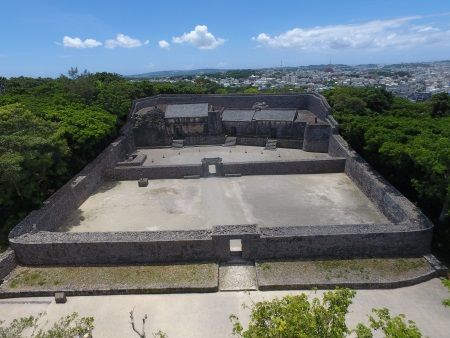
October 19, 2018 Ryukyu Shimpo
On October 19, the National Council for Cultural Affairs reported to the Minister of Education, Culture, Sports, Science and Technology Masahiko Shibayama that the Tamaudun royal mausoleum of the Ryukyu Kingdom will be designated as a national treasure.
In Okinawa Prefecture, a collection of “Ryukyu Sho Dynasty Related Artifacts” owned by Naha City has received national treasure designation, but this is the first time for structures in Okinawa to be recognized as national treasures.
The mausoleum will be officially designated by public notice.
There are 226 national treasures including Tamaudun. Along with its report, the Council indicated eight buildings including Ohmae Shrine (Maoka City, Tochigi Prefecture) as important cultural assets.
King Sho Shin of the Ryukyu Kingdom built Tamaudun in 1501.
It is located to the west of Shuri Castle. The three tombs are enclosed by stone walls in a “hafubaka” style peculiar to the Ryukyu region.
It is the oldest and largest scale mausoleum of this style that exists today. Naha City owns the mausoleum.
Tamaudun is one of the properties that was registered on the World Cultural Heritage list in 2000 under “Gusuku Sites and Related Properties of the Ryukyu Kingdom.”
The three tombs and two stone walls that surround them are the structures being reported as national treasures at this time.
Mayor Mikiko Shiroma of Naha City said, “As citizens, we are extremely pleased and proud to designate structures in the prefecture as national treasures for the first time.
I will strive to preserve and protect valuable cultural assets in order to pass down.”
(English translation by T&CT and Megumi Chibana)
Go to Japanese
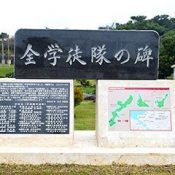
October 23, 2018 Ryukyu Shimpo
The prefecture of Okinawa recently passed a decision to add a supplemental plaque next to the Cenotaph for All Student Corps (Zen Gakutotai no Hi) located in Mabuji, Itoman City.
The plaque will bear the total number of student casualties of the war, who were enrolled in either teacher-training colleges or all-boys’ middle schools.
The Association for Former Gakutotai Student Corps Members, formed by former students of the 21 Okinawan schools that were mobilized for the war effort, had been pressing the prefecture to add the death toll to the cenotaph.
The additional plaque will inform visitors that 1,983 students lost their lives during the war, a number determined by the Association.
The cenotaph itself is located at the Peace Memorial Park in Itoman City, and was unveiled on March 14, 2017.
The monument is the result of appeals made by two alumnae of the Showa All-Girls’ High School, Hatsue Yoshikawa, 90, and Hatsuko Uehara, 89.
The cenotaph displays the names of the 21 Okinawan schools, but did not include information on the death toll.
The Association for Former Gakutotai Student Corps Members filed a petition with the prefectural assembly in April, stating that including the death toll will help convey the tragedy of the Battle of Okinawa beyond the current generation.
The prefectural assembly was cautious, stating that an accurate count had not been determined.
According to both parties, the prefecture informed the Association of its decision in September.
One of Okinawa’s top officials said, “Although the budget has not yet been allocated, we are working to have the plaque installed as soon as possible.”
The installation is expected to be completed by the end of the current fiscal year.
(English translation by T&CT and Monica Shingaki)
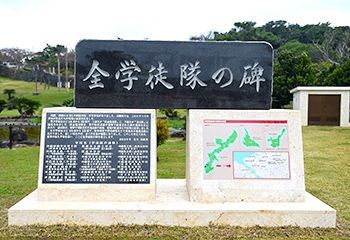
Cenotaph for All Student Corps (Zen Gakutotai no Hi)
Go to Japanese
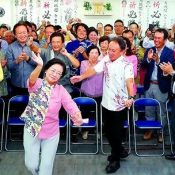
October 22, 2018 Ryukyu Shimpo
“Yes, yes, yes!” When her re-election was announced on television at 8:00 p.m., Mikiko Shiroma, 67, struck a victory pose, pumping her fist in the air.
Cheers and whistles erupted at her campaign office in Matsuyama, Naha City, and applause filled the air.
Shiroma, surrounded by smiles and kachaashii dancing, pledged resolutely, “I will give all I’ve got as the ‘mother’ of Naha City for the sake of the people’s happiness!”
Four years ago, Shiroma was the first woman elected to be mayor of Naha City.
She took the reins from former Governor Takeshi Onaga and advanced collaborative community development.
However, her mayorship in many ways resembled a continuation of Onaga’s administration, and many wondered, “what does Shiroma bring to the table?”
Shiroma developed her own style as a leader–“My specialties are education and child-raising, making use of my experience as a schoolteacher.
City employees and residents help make up for areas where I’m lacking.”
“Do your best.” Those were Onaga’s words to her on July 24, when she announced that she was running for a second term.
Roughly two weeks later, Onaga, who had been her classmate in junior high and high school, passed away suddenly.
She cried until her eyes were red. On the day the election officially commenced, Shiroma was entrusted by Onaga’s supporters with a green ribbon, green having been Onaga’s color.
She fought her campaign with the ribbon pinned to her sash at all times as an amulet.
Shiroma found time to canvas and campaign while continuing her duties as a public official, giving speeches at as many as twenty or more locations on some days.
When faced with criticism that she hasn’t shown any results, she placed her trust in the people, saying, “I know that the people of Naha understand what I have accomplished.”
By the end of the day she would be too exhausted to even eat dinner, but she continued to carry her slight frame to every corner of the city, encouraged by supporters’ urging, “keep at it” and “we support you.”
Upon hearing the announcement of her re-election, Shiroma gripped a white handkerchief and quietly unfolded it.
A green ribbon peeped out.
A gentle smile filled Shiroma’s face as she embraced her supporters, saying, “We can’t achieve happiness for the people of Naha if we aren’t at peace.
I will continue to engage in warm and kind administration of the city.”
(English translation by T&CT and Sandi Aritza)
Go to Japanese
October 18, 2018 Ryukyu Shimpo
When Okinawa’s former governor revoked approval for land filling activities as part of the relocation of MCAS Futenma to Henoko in Nago City, the Japanese government took countermeasures. Those came in the form of demanding that the Minister of Land, Infrastructure, and Transportation to review the revocation under the Administrative Appeal Act and cancel the efficacy of the revocation.
In the September 30 gubernatorial election, where Denny Tamaki, the candidate opposed to new base construction, beat his Henoko relocation supporting and Abe administration-backed opponent in a landslide. While this is the second straight time the people of Okinawa have clearly voiced their position in a gubernatorial election opposing a base relocation within Okinawa, the Japanese government continuing to force through the land filling activities can only be called a reckless trampling of democratic values.
To begin with, the Administrative Appeal Act was passed with the purpose of supporting citizens’ rights and interests when a government agency acts illegally or inappropriately. Therefore, the government itself cannot use the same law in this way.
Regardless, when the land-filling approval was revoked by Okinawa in 2015, the Okinawa Defense Bureau (ODB) stressed that they were a “private entity,” and requested that the revocation be suspended. This was accepted by the Minister of Land, Infrastructure, and Transportation. For the government to abuse a system made for a regular citizen by insisting that the ODB is a “private entity,” is tantamount to fraud.
The government is once again is taking unthinkably tyrannical measures for a nation of laws. Will the Minister of Land, Infrastructure, and Transportation again use this deceit to support a fixed game?
Keiichi Ishii, the Minister of Land, Infrastructure, and Transportation is a member of the Komeito Party. The Komeito Party head office of Okinawa actually opposes of the relocation of MCAS Futenma. The Okinawa Komeito office should work to see that this absurd endeavor not move forward.
Minister of Defense Takeshi Iwaya, who made the request to the Minister of Land, Infrastructure, and Transportation, stressed, “We are working to remove the dangers of MCAS Futenma and return the land as quickly as possible.” While he commented that he “takes very seriously” the results of the Okinawa gubernatorial election, he made clear his policy to continue with the relocation, citing the need to maintain the U.S. military’s presence as a deterrent, while also alleviating the burden of the bases on Okinawa.
While “deterrence” has become a cliché, its foundation was not explained in a logical manner. The U.S. Marines main duties include amphibious assault utilizing helicopters and amphibious assault vehicles, as well as land-based special operations.
From a military standpoint, many experts have stated that the reasons for deploying the Marines to Okinawa are meager. Okinawa already hosts many U.S. military bases including Kadena Air Base, the largest U.S. base in the Asia-Pacific region. If MCAS Futenma were to no longer exist, it would pose no hindrance to the U.S. military.
Governor Tamaki has appealed to the country, “People of Japan, I want you all to see clearly that despite Okinawa’s overwhelming opposition to a new base, the current administration has responded to the will of the people in an authoritarian manner.”
The path of dialogue with Okinawa has been shut from one side, and without the ability to argue the new base construction plunges ahead. The behavior of the Abe administration, violating the will of the people of the region, should be threatening to people all over Japan. This is not a problem for Okinawa alone.
(English translation by T&CT and Sam Grieb)
Go To Japanese
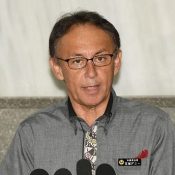
October 17, 2018 Ryukyu Shimpo online edition
On October 17 starting at 4:40 p.m. Governor Denny Tamaki answered questions from a group of reporters at the Prefectural Office. He spoke about the central government’s request for an injunction to overturn revocation of the land reclamation permit, relating to construction work at the shore of Henoko.
Governor Tamaki said: “I requested discussions toward a solution with Prime Minister Abe, Chief Cabinet Secretary Suga, and perhaps other officials. Yet merely five days later the central government’s approach is to take legal measures [against revocation]. It is by no means acceptable to trample on the popular will of Okinawans, which was once again demonstrated in the [Okinawa] gubernatorial election.”
With a grim expression and his voice full of anger throughout his time talking with the press, Governor Tamaki explained the way in which the Okinawa Prefectural Government (OPG) is considering these circumstances. He spoke about the central government’s decision to ask for an injunction from the Minister of Land, Infrastructure, Transport and Tourism, based on the Administrative Complaint Review Act. Tamaki said, “This Act is meant to support Japanese citizens’ rights and interests. By using it, the central government is distorting the intent of the institution. It is illegal, and I cannot fathom that this is an act of a constitutional nation.”
Also, Governor Tamaki commented on fact that revocation of the land reclamation permit has kept construction at bay for more than a month and a half, while in 2015 when former governor Onaga rescinded the permit it was reinstated the very next day. Tamaki said: “It is of urgent importance that we absolutely do not allow [revocation to be reversed]. Should the Minister of Land, Infrastructure, Transport and Tourism cancel the revocation, the interior of the Cabinet will be unjustly dominating [the situation].”
Governor Tamaki also addressed how the OPG plans to engage with the central government going forward. He said, “I have just requested that Prime Minister Abe promptly arrange an occasion for us to have discussions, and I will push for an ongoing dialogue.”
In addition, Governor Tamaki called on the people of Japan and Okinawa, saying, “I implore the people of Japan to see the reality of the current administration’s overly authoritarian resistance to Okinawans’ popular will, to move toward a public committment against building the new base in Henoko, and to do so earnestly.”
(English translation by T&CT and Erin Jones)
Go To Japanese
October 22, 2018 Ryukyu Shimpo
In response to Kyoto University retaining human remains removed by anthropologists from Okinawa in the early Showa era, several organizations including the Nara-Okinawa Solidarity Commission have established a group called the Nara Prefectural Council Requesting Ryukyuan Remains be Returned. On October 21 the group met in Nara City in support of bringing a lawsuit against Kyoto University to have the remains returned.
Head Secretary Hideki Kanai of the group gave a lecture titled “Japanese Colonialism and the Issue of Returning Ryukyuan Remains.” Participants adopted a declaration that stated, in part, “We are concerned there is colonialism still among us, and we call on Japan to relinquish its hold, as a postwar duty of a suzerain nation.” The group will actively support Okinawa’s right of self-determination and oppose construction of the Futenma replacement facility in Henoko, Nago City.
The group took on representatives from the Nara-Okinawa Solidarity Commission, Okinawa no Takae-Henoko Tsunagaru Nara no Kai, and the Multicultural Coexistence Forum of Nara. In total, the three organizations have about 300 members. Other organizations cooperating in the group’s activities include the Buraku Liberation League’s Nara Branch and the Nara Peace Forum. A representative of the group, Seiki Sakihama, said, “Uchinanchu and Yamato together, including people of Amami from whom remains were snatched in a similar fashion, want to call out Japan’s colonialism.”
(English translation by T&CT and Erin Jones)
Go To Japanese
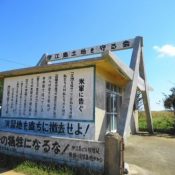
October 13, 2018 Ryukyu Shimpo
On October 9 repairs were started on the “Solidarity Dojo” in Maja, Ie Village, which the late Shoko Ahagon used as the base of land struggles in the resistance movement against the U.S. military. Because the repairs will cost about 10 million yen, the Wabiai no Sato Foundation and volunteers are carrying on Ahagon’s memory by launching the Iejima Solidarity Dojo Preservation Society and seeking donations. President of the Preservation Society, Etsuko Jahana, is calling for cooperation with the words, “We want to leave the symbol of Iejima’s land struggle for future generations.”
The Solidarity Dojo was completed in 1970. It has been used as a place for studying the history and ideology of the nonviolent resistance in the land struggle. The names of individuals and organizations that supported the Iejima Land Protection Association’s activities are placed in the building. This includes a wide range of people, such as the first elected Okinawa governor Chobyo Yara and former chairman Baldwin of the International Human Rights Federation.
As the building has aged, concrete has detached and fallen away. The repair work is expected for completion in March next year. Visitors are not allowed to enter the building during repairs.
Kozo Takagaki, a member of Wabiai no Sato, talked about the significance of preserving the dojo as “a historic building that stands as a record of the nonviolent resistance on Ie Island.” Jahana stressed, “The base problem after the war began on Ie Island. Those records are here.”
Donations start at 2,000 yen for individuals and 10,000 yen for organizations. These donations will be received at JP Bank “Wabiai no Sato Foundation” Symbol 17010, Number 20371481. For inquiries, call Wabiai no Sato at 0980 (49) 3047.
(English translation by T&CT and Megumi Chibana)
Go To Japanese

October 23, 2018 Ryukyu Shimpo
The Okinawa Resort Wedding Committee (Yoshiaki Ogawa, spokesperson), made up of representatives from wedding-industry companies, has been working to develop the Chinese market. The committee is looking to establish a “Resort Wedding Tourism” business model that combines resort weddings and local sightseeing, and they were selected for the Japan Tourism Agency’s (JTA) business model project. The team is looking to strengthen their PR for Chinese customers, a relatively stagnant customer base, and hopes to increase demand on mainland China and attract new customers.
According to the committee, in 2017, the number of resort weddings increased 10% from the previous year to 17,288. Domestic customers accounted for 80% of that number, with Taiwan and Hong Kong accounting for most of the customers from abroad. There were only 164 weddings from mainland Chinese customers, and committee member Toshihiko Uechi indicated that the stagnant customer figures is due to, “an information wall in China, despite the large number of flights [from China].”
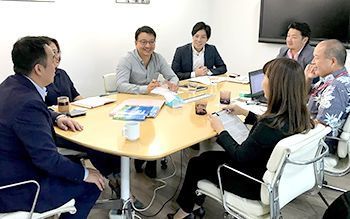
The Okinawa Resort Wedding Committee discussing Chinese customer needs with Chinese wedding sales companies in Beijing (photograph provided by the committee)
Mika Kawano, along with the committee’s inbound promotion members, traveled to Beijing from October 10-13 to meet with 6 wedding sales companies, where they learned about Chinese customers’ needs. There are approximately 12 million weddings in China annually, with 20,000 of those having their ceremonies overseas. Popular destinations include Bali in Indonesia and Phuket in Thailand. One unique characteristic of Chinese wedding ceremonies is the demand for a wedding videos staring the bride and groom. Kawano says, “The wedding videos, which they can take with them and show to others, is popular.” There are companies that specialize in the creation of these wedding videos, and the proportion of income gained from these videos leans heavily towards customers from distant regions.
Chinese wedding sales companies have indicated that customers have noted the need for a visa when coming to Okinawa as well as the inconvenience of not being able to drive a rental car with a Chinese driver’s license. Conversely, many Chinese customers are fond of, “the beaches that are more beautiful than Bali,” as well as Japan’s renown high quality. There is an indication of an appetite for buying wedding plans in Japan, and “if the wedding is in Japan, the expensive price tag is not an issue.”
On December 1, the committee will be sending eight companies to a wedding convention in Beijing. The committee is also in talks to invite Chinese wedding sales companies to Okinawa, and they are making a PR video to strengthen sales in the region. Uechi said, “We are aiming to add value with drones and VR, and to increase consumer spending and extend the length of stay on the island.”
(English translation by T&CT and Sam Grieb)
Go To Japanese
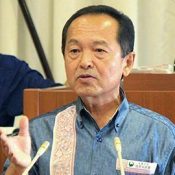
October 16, 2018 Ryukyu Shimpo
By Ayako Sakaguchi
On October 15, Okinawa Prefecture Nago City Mayor Taketoyo Toguchi declared he will work to remove all seven helipads within U.S. military Camp Schwab. During the city council plenary meeting, he declared he would “strongly appeal” for the removal. He also declared, “You can take (removing the helipads) as a pledge.” During the city mayoral election in February, Mayor Toguchi had not listed the removal of the helipads in Camp Schwab as one of his pledges. During the city council regular meeting in March, he had expressed his intent to request the removal of the helipad near the National Institute of Technology, Okinawa College. However, this is the first time in which he declared the removal of all seven helipads within Camp Schwab as a pledge.
As a general question, city council member Takuma Higashionna had asked, “Can we take this as you promising to remove all helipads?” To which Mayor Toguchi responded, “I’ve mentioned this several times before. It’s fine if you want to take it as my pledge.”
Regarding the helipad close to the college, only about 300 meters away, Mayor Toguchi visited Itsunori Onodera, the Minister of Defense at the time. Mayor Toguchi had verbally requested the swift removal of the helipad.
Synchronizing the Three Wards of Kube
There is some history surrounding the helipads within U.S. military Camp Schwab. In December 2016 in Abu of Nago City, a U.S. Marine Corps vertical takeoff/landing transport aircraft MV-22 Osprey crash landed. Following this, headmen of Henoko, Toyohara, and Kushi (collectively known as the “Three Wards of Kube) requested to Kenji Wakamiya, the State Minister of Defense at the time, the removal of the helipads. It has been nearly two-years since the accident, but there is no movement to remove the helipads. U.S. military aircrafts continue to fly over communities and local residents continue to be troubled by the noise pollution.
The helipad LZ Phoenix behind the National Institute of Technology, Okinawa College, which Mayor Toguchi requested an early removal, is located about 300 meters from the college grounds. U.S. military aircrafts, such as Ospreys, continue to practice takeoff and landing there.
Sympathizing with the local residents, Mayor Toguchi requested to the Ministry of Defense the removal of the helipads. He will continue to “strongly appeal” his case and will do this in earnest. Except when asked about the process leading up to the removal of the helipads, he merely explained that he verbally made a request to the Ministry of Defense. Specific routes he plans to take are unclear. His competency will be questioned based on how he plans to make the removal happen.
(English translation by T&CT and Chelsea Ashimine)
Go To Japanese
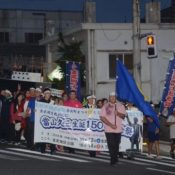
October 15, 2018 Ryukyu Shimpo
The town of Kin celebrated the 150th birthday of Kyuzo Toyama (1868–1910), the “forefather of emigration,” on October 14, attracting many residents and out-of-town visitors. In Toyama’s day, Kin’s resilient town spirit had successfully delivered an emigration program while overcoming difficulties; as a tribute, the Kin residents organized a large-scale procession and a play portraying the life of Toyama to reaffirm its commitment to pass down this spirit to the next generation.
Born in Namizato, Kinmagiri (current day Namizato, Kin) in 1868, Toyama sent 30 of the first Okinawan emigrants to Hawaii in 1899. Many have since followed suit. The emigrants, in turn, sent back generous donations to help their devastated hometown after the war, which kickstarted the recovery.
A ceremony also took place at dondan-gwa (current day Kin, Kin), which was the departure point for Okinawan emigrants. There, the five districts that comprise Kin put on karate and shishimai (lion dance) performances, adding excitement to the festivities.
“I didn’t know Okinawan emigration began in Kin. It’s inspired me to take on new challenges,” said Yuki Kinjo, 28, who visited from Ginoza with friends.
(English translation by T&CT and Monica Shingaki)
Go To Japanese
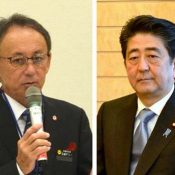
October 12, 2018 Ryukyu Shimpo online edition
On the afternoon of October 12 at the Kantei, the prime minister’s official residence, for the first time since he assumed office Okinawa Governor Denny Tamaki had a conference with Prime Minister Shinzo Abe and Chief Cabinet Secretary Yoshihide Suga.
At the beginning of the conference Governor Tamaki reiterated that Okinawans’ popular will says that they cannot accept the construction of the Futernma replacement facility in Henoko, and expressed his own opposition to construction of the facility.
He went on to say: “The burden of the security treaty is an issue borne by the country as a whole. I hope [the central government] will promptly prepare an occasion on which to discuss this, with the understanding that it is a democratic issue.”
In addition, Governor Tamaki requested a meeting of the Futenma Air Station Burden Reduction Promotion Council, and a conference with the United States.
He said, “Regardless of construction in Henoko, MCAS Futenma should be returned within the five-year period.”
Prime Minister Abe spoke about the high concentration of U.S. bases on Okinawa.
He said: “It is not something of which I can approve. As I embrace prefectural citizens’s sentiments, I hope to steadily reduce the base burden step by step.”
(English translation by T&CT and Erin Jones)
Go to Japanese











 Webcam(Kokusai Street)
Webcam(Kokusai Street)


